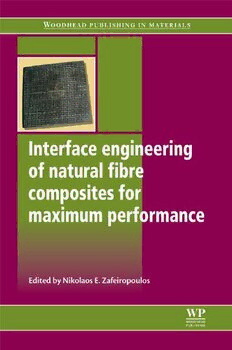Download Interface Engineering of Natural Fibre Composites for Maximum Performance PDF Free - Full Version
Download Interface Engineering of Natural Fibre Composites for Maximum Performance by N.E. Zafeiropoulos in PDF format completely FREE. No registration required, no payment needed. Get instant access to this valuable resource on PDFdrive.to!
About Interface Engineering of Natural Fibre Composites for Maximum Performance
One of the major reasons for composite failure is a breakdown of the bond between the reinforcement fibers and the matrix. When this happens, the composite loses strength and fails. By engineering the interface between the natural fibers and the matrix, the properties of the composite can be manipulated to give maximum performance. Interface engineering of natural fiber composites for maximum performance looks at natural (sustainable) fiber composites and the growing trend towards their use as reinforcements in composites.Part one focuses on processing and surface treatments to engineer the interface in natural fiber composites and looks in detail at modifying cellulose fiber surfaces in the manufacture of natural fiber composites, interface tuning through matrix modification and preparation of cellulose nanocomposites. It also looks at the characterization of fiber surface treatments by infrared and raman spectroscopy and the effects of processing and surface treatment on the interfacial adhesion and mechanical properties of natural fiber composites. Testing interfacial properties in natural fiber composites is the topic of part two which discusses the electrochemical characterization of the interfacial properties of natural fibers, assesses the mechanical and thermochemical properties and moisture uptake behavior of natural fibers and studies the fatigue and delamination of natural fiber composites before finishing with a look at Raman spectroscopy and x-ray scattering for assessing the interface in natural fiber composites.
Detailed Information
| Author: | N.E. Zafeiropoulos |
|---|---|
| Publication Year: | 2011 |
| ISBN: | 9781845697426 |
| Pages: | 428 |
| Language: | English |
| File Size: | 12.08 |
| Format: | |
| Price: | FREE |
Safe & Secure Download - No registration required
Why Choose PDFdrive for Your Free Interface Engineering of Natural Fibre Composites for Maximum Performance Download?
- 100% Free: No hidden fees or subscriptions required for one book every day.
- No Registration: Immediate access is available without creating accounts for one book every day.
- Safe and Secure: Clean downloads without malware or viruses
- Multiple Formats: PDF, MOBI, Mpub,... optimized for all devices
- Educational Resource: Supporting knowledge sharing and learning
Frequently Asked Questions
Is it really free to download Interface Engineering of Natural Fibre Composites for Maximum Performance PDF?
Yes, on https://PDFdrive.to you can download Interface Engineering of Natural Fibre Composites for Maximum Performance by N.E. Zafeiropoulos completely free. We don't require any payment, subscription, or registration to access this PDF file. For 3 books every day.
How can I read Interface Engineering of Natural Fibre Composites for Maximum Performance on my mobile device?
After downloading Interface Engineering of Natural Fibre Composites for Maximum Performance PDF, you can open it with any PDF reader app on your phone or tablet. We recommend using Adobe Acrobat Reader, Apple Books, or Google Play Books for the best reading experience.
Is this the full version of Interface Engineering of Natural Fibre Composites for Maximum Performance?
Yes, this is the complete PDF version of Interface Engineering of Natural Fibre Composites for Maximum Performance by N.E. Zafeiropoulos. You will be able to read the entire content as in the printed version without missing any pages.
Is it legal to download Interface Engineering of Natural Fibre Composites for Maximum Performance PDF for free?
https://PDFdrive.to provides links to free educational resources available online. We do not store any files on our servers. Please be aware of copyright laws in your country before downloading.
The materials shared are intended for research, educational, and personal use in accordance with fair use principles.

